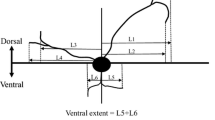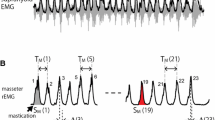Summary
-
1.
In each right and left buccal ganglia of Aplysia kurodai, we identified 4 premotor neurons impinging on the ipsilateral jaw-closing and -opening motoneurons. Three of them (MA1 neurons) had features of multifunctional neurons. Current-induced spikes in the MA1 neurons produced excitatory junction potentials (EJPs) in the buccal muscle fibers. In addition, tactile stimulation of the buccal muscle surface produced a train of spikes in the MA1 neurons without synaptic input. The other neuron (MA2) had only a premotor function.
-
2.
The MA1 and MA2 neurons had similar synaptic effects on the jaw-closing and -opening motoneurons. Current-induced spikes in the premotor neurons gave rise to monosynaptic inhibitory postsynaptic potentials (IPSPs) in the ipsilateral jaw-closing motoneurons. Simultaneously, spikes in one of the MA1 neurons and the MA2 also gave rise to monosynaptic excitatory postsynaptic potentials (EPSPs) in the ipsilateral jaw-opening motoneuron.
-
3.
The IPSPs and the EPSPs induced by spikes in the premotor neurons were reversibly blocked by d-tubocurarine and hexamethonium, respectively, suggesting that the MA1 and MA2 neurons are cholinergic.
-
4.
When depolarizing and hyperpolarizing current pulses were passed into one premotor neuron, attenuated but similar potential changes were produced in another randomly selected premotor neuron in the same ganglion, suggesting that they are electrotonically coupled
Similar content being viewed by others
Abbreviations
- ASW :
-
artificial seawater
- d-TC d :
-
tubocurarine
- EJP :
-
excitatory junction potential
- EPSP :
-
excitatory postsynaptic potential
- I 1, I 3 :
-
intrinsic buccal muscles
- IPSP :
-
inhibitory postsynaptic potential
- JC1-JC3 :
-
jaw-closing motoneurons
- JO1 :
-
jaw-opening motoneuron
- MA1, MA2 :
-
premotor neurons
- n 2, n 3 :
-
buccal nerve 2, 3
- O-1, O-2 :
-
jaw-opening phase
References
Ascher P, Kehoe JS (1975) Amine and amino acid receptors in gastropod neurons. In: Iversen LL, Iversen SD, Snyder SH (eds) Handbook of psychopharmacology, vol 4. Plenum, New York, pp 265–310
Audesirk TE, Audesirk GJ (1979) Oral mechanoreceptors in Tritonia diomedea. II. Role of feeding. J Comp Physiol 130:79–86
Beltz B, Gelperin A (1980) Mechanism of peripheral modulation of salivary burster in Limax maximus: a presumptive sensorimotor neuron. J Neurophysiol 44:675–686
Carpenter DO, Swann JW, Yarowsky PJ (1977) Effect of curare on responses to different putative neurotransmitters in Aplysia neurons. J Neurobiol 8:119–132
Coggeshall RE (1971) A possible sensory-motor neuron in Aplysia californica. Tissue Cell 3:637–648
Cohen JL, Weiss KR, Kupfermann I (1978) Motor control of buccal muscles in Aplysia. J Neurophysiol 41:157–180
Croll RP, Davis WJ (1981) Motor program switching in Pleurobranchaea. I. Behavioral and electromyographic study of ingestion and agestion in intact specimens. J Comp Physiol 145:277–287
Fiore L, Meunier JM (1979) Synaptic connections and functional organization in Aplysia buccal ganglia. J Neurobiol 10:13–29
Gardner D (1971) Bilateral symmetry and interneuronal organization in the buccal ganglia of Aplysia. Science 173:550–553
Gardner D (1977) Interconnections of identified multiaction interneurons in buccal ganglia of Aplysia. J Neurophysiol 40:349–361
Gardner D, Kandel ER (1977) Physiological and kinetic properties of cholinergic receptors activated by multiaction interneurons in buccal ganglia of Aplysia. J Neurophysiol 40:333–348
Howells HH (1942) The structure and function of the alimentary canal of Aplysia punctata. Q J Microsc Sci 83:357–397
Jahan-Parwar B, Wilson AH Jr, Fredman SM (1983) Role of proprioceptive reflexes in control of feeding muscles of Aplysia. J Neurophysiol 49:1469–1480
Kandel ER (1976) Cellular basis of behavior. Freeman, San Francisco
Kupfermann I, Cohen J (1971) The control of feeding by identified neurons in the buccal ganglion of Aplysia. Am Zool 11:667
Nagahama T, Takata M (1987) Food-induced firing patterns in motoneurons innervating the pharynx of Aplysia kurodai. J Comp Physiol A 161:799–809
Nagahama T, Takata M (1988) Food-induced firing patterns in motoneurons producing jaw movements in Aplysia kurodai. J Comp Physiol A 162:729–738
Nagahama T, Takata M (in press) Neural mechanism generating firing patterns in jaw motoneurons during the food-induced response in Aplysia kurodai. II. Functional role of premotor neurons on generation of firing patterns in motoneurons. J Comp Physiol A
Peters M, Altrup U (1984) Motor organization in pharynx of Helix pomatia. J Neurophysiol 52:389–409
Rosen SC, Weiss KR, Cohen JL, Kupfermann I (1982) Interganglionic cerebral-buccal mechanoafferents of Aplysia: receptive fields and synaptic connections of different classes of neurons involved in feeding behavior. J Neurophysiol 48:271–288
Segal MM, Koester J (1982) Convergent cholinergic neurons produce similar postsynaptic actions in Aplysia: implications for neural organization. J Neurophysiol 47:742–759
Van Wilgenburg H, Milligan JV (1976) Neurons in the suboesophageal ganglion complex of the snail, Helix pomatia, having a functional relation to cardio-respiratory activity. In: Salanki J (ed) Neurobiology of invertebrates. Akademiai Kiado, Budapest, pp 615–628
Author information
Authors and Affiliations
Rights and permissions
About this article
Cite this article
Nagahama, T., Takata, M. Neural mechanism generating firing patterns in jaw motoneurons during the food-induced response in Aplysia kurodai . J Comp Physiol A 166, 143–150 (1989). https://doi.org/10.1007/BF00193459
Accepted:
Issue Date:
DOI: https://doi.org/10.1007/BF00193459




